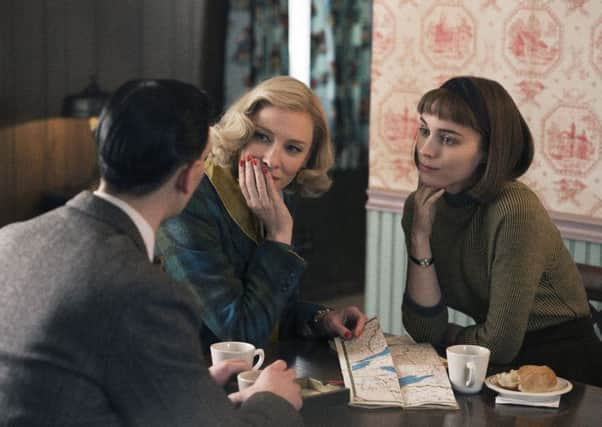Cate Blanchett and a forbidden romance


Cate Blanchett is addressing the question of whether roles for women are improving. In Carol she embraces another in a long line of strong roles that have netted her two Oscars and three more nominations. And as Carol Aird she is odds-on to bag another nod, if not the golden man himself.
Patricia Highsmith wrote The Price of Salt under the nom-de-plume Claire Morgan. It was based on a moment she experienced as a shop assistant when she spied a blonde woman across the floor of the store where she worked.
Advertisement
Hide AdAdvertisement
Hide AdOther elements were based on the life of her former lover, socialite Virginia Kent Catherwood. The book, published in 1952 and marketed as “the novel of a love society forbids” eventually sold in excess of a million copies.
Her book tells the story of married mother Carol Aird and shop clerk Therese Belivet, who fall in love and embark on a road trip that takes them off on a journey that breaks every moral rule. Autobiographical, based on fact and given the rarity of a happy-ish ending, The Price of Salt (later retitled Carol) featured a pair of women revealed as homosexual but who nonetheless defied the stereotypes of 50s America. Sixty years later 46-year-old Blanchett can still see the relevance of the story.
“The wonderful thing about this book and about Patricia Highsmith’s work generally is that you have both male and female perspectives delivered in mesh. Yes, there are two women at the centre of it but it’s not a niche experience. It fell off the agenda and I think we lost a lot of ground but it’s great to be working with female producers wanting to make great, intelligent films. That’s what everyone wants to make, isn’t it?”
Blanchett is referring to producers Elizabeth Karlsen and Christine Vachon, and scriptwriter Phyllis Nagy. The director is Todd Haynes, with whom she previously collaborated on I’m Not There.
Advertisement
Hide AdAdvertisement
Hide AdThe film is rooted in the 1950s but says Blanchett, the themes are as significant as ever.
There are, she points out, “70 countries around the world in which homosexuality is still illegal” so she wonders about the notion of criminal love. “The thing about playing a character like Carol is that her sexuality is a private affair. What often happens these days is that if you are homosexual you have to talk about it constantly; it has to be the thing you put before your work and all aspects of your personality.
“We’re living in deeply conservative times and if we think otherwise then we’re very foolish. It still seems to be an issue. [But] we’re talking about it.”
Adds co-star Rooney Mara, who plays Therese: “In America there’s been great progress made from when this story takes place. Like Cate said, I think we’d be foolish to think that it ends there. That’s not the case everywhere in the world and we still have a long way to go before we’re not talking about it.”
Advertisement
Hide AdAdvertisement
Hide AdTo play Carol, Blanchett immersed herself in erotica and books that explored the secret world she floats through. She calls them “outsider novels” and points out that The Price of Salt occupies a unique place in literary history.
“This very personal, intimate novel was the first lesbian story that had a happy ending. I read many, many that did not. It is important to remember that that was not the case then. That was not a world in which Carol herself existed.
“She was not a card-carrying member of any sexual persuasion and that’s also important to remember: that those labels, those environments, those groups and the comfort of those communities did not exist for many people in that period.”
Carol is a love story that breaks boundaries and shatters perceptions. At its core is a sex scene that is both erotic and loving in its content and delivery. The nudity is sensitively handled. Blanchett recalls being nervous but not for reasons of nudity.
Advertisement
Hide AdAdvertisement
Hide Ad“It’s really great when it’s not [done] for titillating reasons. It was a really, really important scene in the structure of the film, in the telling of the story. There was a bit of apprehension going in but not because it was between two women. Todd was fantastic in explaining how it was going to be shot: it was a scene like any other scene.”
Perhaps inevitably Blanchett is asked to consider whether her admission in Variety that she had loved other women will give hope and succour to other females whose true sexuality remains in the closet. “From memory the conversation ran, ‘Have you had relationships with women?’ and I said, ‘yes, many times. If you mean have I had sexual relationships with women the answer is no.’ But that obviously didn’t make it to print.” She laughs.
But she is keen to make a point. Being selectively quoted allows her to focus on the real issue.
“In 2015 the point should be, who cares? Call me old-fashioned but I thought one’s job as an actor was not to present one’s boring, small, microscopic universe but to make a psychological and empathetic connection to another character’s experience so that you can present something other than your own world to an audience.
Advertisement
Hide AdAdvertisement
Hide Ad“What I love about being an actor is finding out other people’s experience. It’s making that tangible and beautiful to an audience in the hope that it will communicate something. My own life is of no interest to anyone else.”
Carol (15) is on general release.